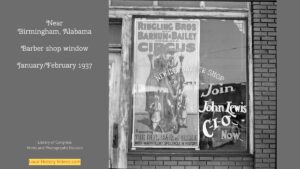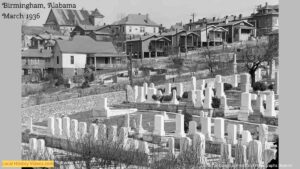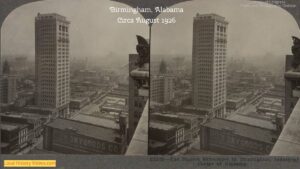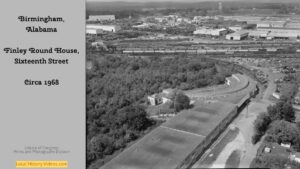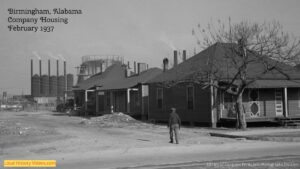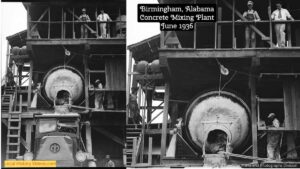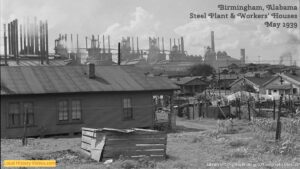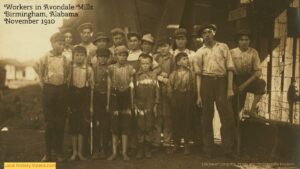The labor movement in Birmingham, Alabama, has been a significant part of the city’s industrial history, characterized by a struggle for workers’ rights, labor organization, and social justice.
Here are key facts about the movement, along with sources for further reading:
- Industrial Foundations: Birmingham’s labor movement emerged in the late 19th and early 20th centuries, driven by the city’s booming steel and iron industries. The presence of major industrial enterprises like U.S. Steel and the Tennessee Coal, Iron and Railroad Company provided a workforce that was ripe for union organization.
- Early Union Efforts: The first significant labor organizations in Birmingham formed in the 1930s. The United Mine Workers of America (UMWA) played a pivotal role, advocating for coal miners’ rights, who often worked in perilous conditions for low wages. In addition to UMWA, unions seeking to improve conditions for workers in factories and railroads began to emerge.
- The 1930s Strikes: The labor movement gained traction during the Great Depression, with several notable strikes occurring. In 1934, a labor dispute at the Tennessee Coal, Iron and Railroad Company led to a significant strike, highlighting the desperate state of workers and the need for better pay and working conditions.
- Civil Rights Context: Birmingham’s labor movement was closely tied to the civil rights movement. Black workers faced severe discrimination and were often excluded from joining unions. This exclusion led to the formation of separate labor organizations, which fought not only for better wages but also for civil rights. The Birmingham chapter of the Brotherhood of Sleeping Car Porters, a significant African American union, played a crucial role in advocating for both labor and civil rights.
- Legacy and Impact: The labor movement in Birmingham set the stage for critical advancements in workers’ rights and social justice that reverberated throughout the region. It helped in the eventual integration of unions and laid the groundwork for broader civil rights initiatives.
The CIO
The CIO was a major federation of unions in the United States and Canada that played a significant role in the labor movement during the 1930s and 1940s. It was primarily focused on organizing industrial workers and advocating for their rights. The CIO sought to improve working conditions, wages, and fair labor practices, particularly for those in low-wage industries.
Sources for Further Reading
- Articles from the Alabama Historical Association – Access specific articles detailing the labor history in Birmingham through their publications, which often include primary sources and analyses.
- University of Alabama at Birmingham Archives – The archives contain collections of documents and photographs related to Birmingham’s industrial and labor history.
These sources will provide a deeper understanding of the multifaceted nature of the labor movement in Birmingham, illustrating its historical significance and ongoing legacy.
More about Alabama
- Labor Rights in Old Birmingham, AlabamaThe labor movement in Birmingham, Alabama, has been a significant part of the city’s industrial history, characterized by a struggle for workers’ rights, labor organization, and social justice. Here are key facts about the movement, along with sources for further reading: The CIO The CIO was a major federation of unions in the United States… Read more: Labor Rights in Old Birmingham, Alabama
- Birmingham, Alabama in the 1930sStep back in time to 1930s Birmingham, Alabama, a vibrant city struggling with the impact of the Great Depresssion.
- Birmingham, Alabama in 1926By 1926, Birmingham, Ala., was at the height of its industrialization and a dynamic, modern place to be.
- The Finley Roundhouse at Birmingham, AlabamaThe Finley Roundhouse was an important part of railway history in Birmingham, Alabama. Abandoned and derelict, its roof was destroyed by a hurricane.
- Company Housing in Old Birmingham, AlabamaAs workers migrated into the expanding city of Birmingham, Alabama the company houses were in high demand.
- Making Concrete in Old Birmingham, AlabamaConcrete was an essential part of growing the city and industries of Birmingham, Alabama.
- The Steel Industry in Birmingham, AlabamaDiscover why steel was such an important part of the local economy in Birmingham, Alabama, USA.
- Old Photos of the Workers of Mobile, AlabamaGlimpse history through old photos of adults and children at work in Mobile, Alabama, USA.
- The Child Workers of Birmingham, AlabamaDiscover the haunting old photos of children who worked in the factories, eateries, messaging and transportation industries of Birmingham, Alabama.
- Old Images of Mobile, AlabamaGlimpse history through old images of Mobile, in Alabama, USA.


